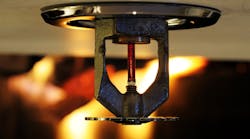6 Ways to Address Water Damage After Fire Suppression and Prevent Mold Growth
Fires are among the worst disasters that building owners and facility managers can experience. A blaze can endanger tenants and other inhabitants and severely damage the property, requiring weeks or even months of cleaning and restoration work.
Further, fire suppression—while absolutely necessary—can also cause problems. Sprinklers and hoses can damage surfaces, leaving the property stained and vulnerable to mold.
In the aftermath of a fire, here are six key strategies for addressing water damage, drying out a property, and preventing mold growth.
1. Remove All Standing Water
Extinguishing a blaze requires a lot of water—water that sticks around even when the flames go out. As an essential first step, building owners and facility managers should work with cleaning and restoration professionals to remove all standing water from the premises. This can be done with pumps, wet vacs and a number of other tools. Be sure to dispose of the water in a way that won’t overwhelm the property’s plumbing.
It’s also crucial to remove soaked materials: wet rugs, carpets and sheetrock should be moved (or disposed of) to prevent mold growth. During this initial step, safety is key. Owners, managers, and the professionals they work with should don rubber boots and gloves (to protect against electrocution) and masks (to protect against contaminated water).
2. Dry and Dehumidify
Once the standing water and water-logged materials are taken care of, the next step involves managing the remaining moisture. This requires maximum ventilation by opening all windows and doors. Strategically positioned high-velocity fans assist in maximizing air circulation, while commercial dehumidifiers efficiently condense water from the air, eliminating excess moisture.
Cleaning and restoration professionals can determine the size and number of fans and dehumidifiers to deploy—they range from portable models to larger industrial-grade units.
3. Disinfect All Wet Surfaces
All surfaces that came into contact with water—walls, floors, ceilings, furniture—should be disinfected. This will remove any chemicals used in the fire suppression, like firefighting foam. Disinfecting these surfaces also prevents mold from gaining a foothold and spreading. It’s far easier—and far less costly—to combat mold proactively, rather than after it proliferates.
4. Scout for Leaks
It’s possible for both the fire and the fire suppression to set the stage for future water damage, too. How? The blaze and the efforts to extinguish it can damage roofs and walls, giving rainwater a way into the property. They can also damage a building’s plumbing, creating leaks. For this reason, it’s crucial for owners and managers to collaborate with cleaning and restoration professionals and thoroughly inspect the property for any holes or broken pipes—and then swiftly fix them.
In the weeks and months after the fire, owners and managers should keep an eye out for discolored walls and ceilings and higher-than-usual water bills, all of which are signals of a potential leak.
5. Double Down on Mold Prevention
In addition to disinfecting all affected surfaces, experts can also apply mold inhibitors. These solutions contain chemicals like hydrogen peroxide and bleach, which can prevent mold growth and destroy existing mold. In cases where mold has deeply penetrated materials, the affected materials should be replaced rather than cleaned.
It's important to note that harsh chemicals like bleach can damage surfaces, so use them judiciously. Bleach has the potential to erode and discolor stone, corrode metal, break down wood and even warp certain plastics.
6. Maintain Low Humidity
Once the cleaning and restoration work is complete, building owners and facility managers should take care to maintain low humidity. In general, humidity levels within a building should stay between 30 and 50% to prevent mold growth. Proper ventilation and air circulation is key.
In some cases, ongoing use of dehumidifiers and air conditioners is necessary. Owners and managers can also invest in moisture-absorbing materials, placing silica gel packets or desiccants in humid areas like basements and bathrooms. Lastly, owners and managers can install humidity monitors, called hygrometers, to continuously stay abreast of humidity levels.
The aftermath of a fire is a stressful and hectic time for building owners and facility managers. However, it’s essential not to overlook water damage and mold mitigation. Properly drying a building after the fire is suppressed will prevent further headaches and damage. Owners and managers can work with cleaning and restoration professionals to ensure their property gets and stays dry.


